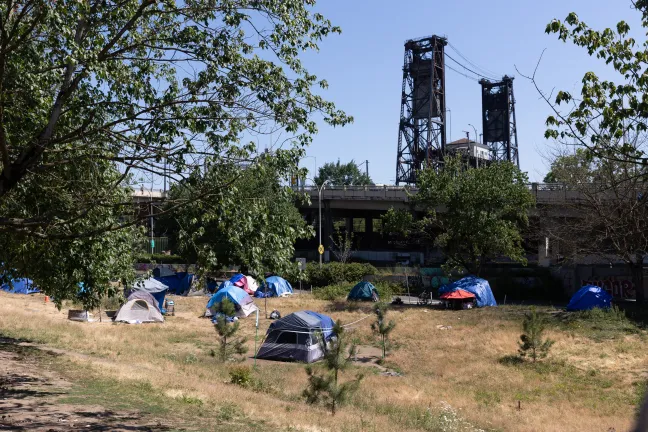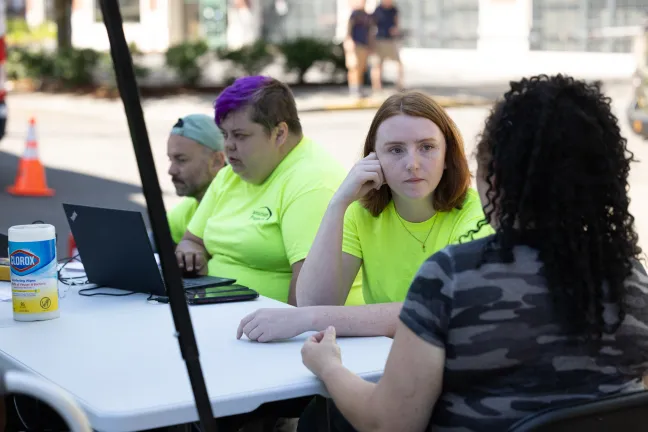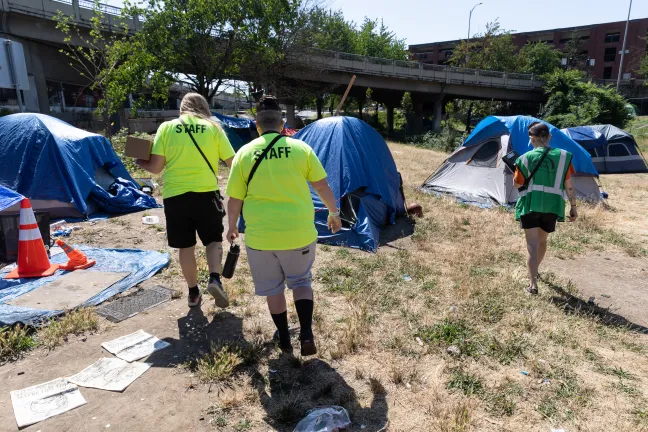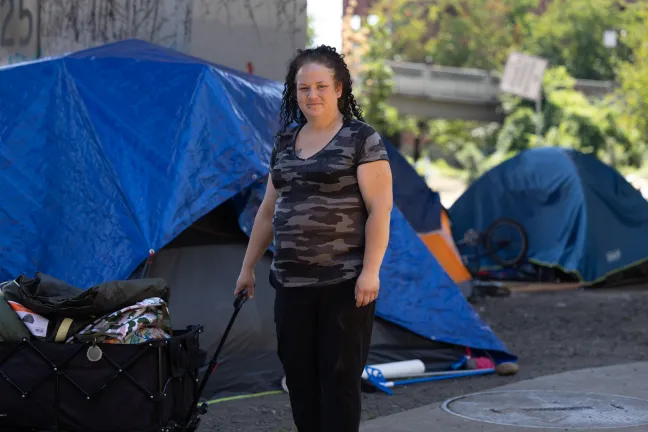On a recent Wednesday, a group of Transition Projects staff arrived at a large encampment under the Steel Bridge known as The Pit, the place they’d been coming every day for more than two weeks.
The staff set up their makeshift office of folding tables and chairs — a place for the case management, outreach, and housing assessment services they’ve been providing for the more than 100 people living in tents in this camp on the edge of Portland’s Old Town. And then they got to work.
Their work is part of Housing Multnomah Now, the newly launched Joint Office of Homeless Services program that aims to connect unsheltered people in a specific geographic area directly to housing, with a focus on helping people navigate around the challenging barriers that might be keeping them on the streets or in and out of shelters.
When Transition Projects’ work launched in early June, their first step was assessing the people living in the area using a new data collection and geolocation tool developed by the Joint Office. The screening not only identified 150 individuals camping beneath the bridge — it also assessed their housing barriers and health needs.
Twenty-three people were enrolled in housing programs, talking regularly with the housing case managers who now meet their clients at the folding tables adjacent to the camp. As of July 17, five have moved into housing, with 15 more waiting for apartments to be ready within just a few weeks.
“This is not typical street outreach,” said William Kastning, the manager of Transition Projects’ Housing Multnomah Now work. Kastning said street outreach is often just focused on people’s immediate needs and building relationships that can eventually lead to connections to longer-term services.
“So, like, ‘I'm thirsty, I need bus tickets, I need the Determination of Homelessness form to get my ID,’” Kastning said. “The difference between traditional outreach and this outreach, which we’re calling proactive outreach, is we're having a conversation of what’s needed in the moment, but then asking, ‘What do you need next?’”
Housing Multnomah Now aims to help people whose desired next step is getting into housing, but who might have significant barriers preventing them from achieving that goal.
“They have a lot of financial debts. They have a criminal record. And they've also been excluded from community services for various reasons — behavioral problems, violence, hate speech,” Kastning said of some of the people living in the camp. “We always wonder, on the service provider side, what happens to people when they're excluded. This is where they end up.”
Part of the work is building trust with people who’ve been experiencing homelessness for a long time, and who may have been left disappointed by services in the past.
Tara Strasburg, a supervisor of the Navigation Team conducting outreach at the site, understands why people living there might be skeptical. She was homeless herself for nearly 10 years, and says she’d be cautious, too. “I would have been the same way when I was out. Lots of agencies make promises that they can't keep,” she said.
Kastning said there aren’t easy solutions for some barriers. But one goal of the pilot program is identifying the most common barriers, and gaps in the system, which is the first step to solving them.
“It has done exactly what we had hoped, exposing a lot of gaps in services,” Kastning said of the program so far. “And it's also exposed a lot of barriers that people have that need to be removed if we expect to move people into housing.”
One of the people receiving help is Jessica, who became homeless during the COVID-19 pandemic. When the pandemic hit, she’d been working as a massage therapist and had recently started a construction company, and both areas of work were hit hard by the pandemic.
“I then started a downward spiral of addiction, unfortunately. Gambling, drugs,” Jessica said. “I was so depressed, because I lost everything.”
In the past, Jessica says she’s gotten “the runaround” when it came to finding housing. She said being homeless and unemployed left her feeling “stuck in a rut, where you don't feel like you're worthy of anything anymore.”
Now, she’s in the process of being housed as a result of Housing Multnomah Now. Through regular meetings with a case manager and other Transition Projects staff, she says she is now just days away from housing. “They already got an apartment for me, almost. The process has been pretty fast,” Jessica said.
She’s excited to move back into housing, and hopes to find work that uses the degree in criminal justice she earned before becoming homeless. “This is a good opportunity for people to get the help that they need,” she said.




